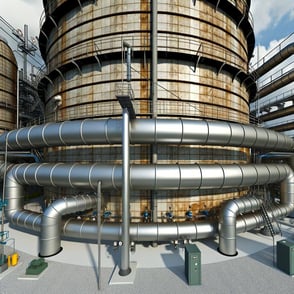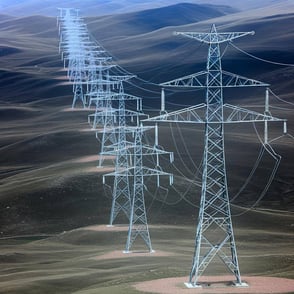Gas-Fired Energy Generation
Gas-fired energy generation uses natural gas to produce electricity, offering high efficiency and low emissions compared to other fossil fuels.
What is Gas-Fired Energy Generation?
Gas-fired energy generation uses natural gas to produce electricity. This form of energy generation is known for its efficiency, reliability, and relatively low carbon emissions compared to other fossil fuels. Gas-fired power plants, also known as natural gas power plants or gas turbine power plants, play a critical role in the global energy mix. They provide a dependable and flexible power supply that can adjust quickly to varying electricity demands, making them essential for maintaining grid stability and supporting the integration of renewable energy sources.
Natural gas, primarily composed of methane, is burned in gas turbines to generate electricity. The process involves converting the chemical energy stored in natural gas into mechanical energy, which is then transformed into electrical energy. This method of electricity production is highly efficient, especially when combined with modern technologies such as combined cycle systems. Gas-fired power plants are also favored for their relatively quick start-up times and ability to provide peak load power during periods of high electricity demand. This puts them on the lower end of the merit-order used in the Day-Ahead Market price formation. Their lower greenhouse gas emissions compared to coal and oil make them a more environmentally friendly option in the fossil fuel category.
How Gas-Fired Energy Generation Works
Gas-fired power plants generate electricity by burning natural gas in a combustion process. There are two main types of gas-fired power plants: simple cycle and combined cycle.
In a simple cycle gas turbine (SCGT) plant, natural gas is burned in a combustion chamber, producing high-pressure, high-temperature gases. These gases are directed through a gas turbine, causing it to spin. The turbine is connected to a generator, which converts the mechanical energy into electrical energy. Simple cycle plants are known for their quick start-up times and are often used during peak electricity demand periods.
Combined cycle gas turbine (CCGT) plants are more efficient than simple cycle plants because they utilize the waste heat produced during the combustion process. In a CCGT plant, natural gas is first burned in a gas turbine to generate electricity, in the same way as in a SCGT. The exhaust gases from the gas turbine, which are still very hot, are then used to produce steam in a heat recovery steam generator (HRSG). This steam drives a steam turbine connected to another generator, producing additional electricity. By combining both gas and steam turbines, combined cycle plants achieve higher efficiency and lower emissions.

In both types of gas-fired power plants, the generated electricity is transmitted to the grid through transformers and transmission lines (similar to other energy generation technologies), ensuring a stable and reliable supply of power to homes and businesses.
The Impact of Gas-Fired Energy on the Energy Sector
Gas-fired energy generation has a significant impact on the energy sector due to its efficiency, reliability, and relatively low carbon footprint. Natural gas power plants produce fewer greenhouse gas emissions than coal-fired plants, contributing to cleaner air and reduced environmental impact. This makes gas-fired generation an essential bridge in the transition towards more sustainable energy sources. Economically, gas-fired power plants play a crucial role in energy markets by providing a flexible and responsive power supply. Their ability to ramp up and down quickly makes them ideal for balancing intermittent renewable energy sources like wind and solar. This flexibility helps stabilize the grid and ensures a consistent electricity supply even when renewable generation fluctuates.
The development of advanced technologies, such as high-efficiency gas turbines and carbon capture and storage (CCS), further enhances the environmental performance of gas-fired power plants. These innovations reduce emissions and improve the overall sustainability of natural gas as a fuel source. However, the reliance on natural gas also presents challenges, including price volatility and supply security concerns. Natural gas markets can be affected by geopolitical events, supply chain disruptions, and market demand fluctuations. To mitigate these risks, many countries are diversifying their energy sources and investing in renewable energy to complement gas-fired generation.
Conclusion
Gas-fired energy generation is a vital component of the modern energy landscape, offering efficient, reliable, and relatively low-carbon electricity production. By burning natural gas, gas-fired power plants provide a flexible power supply that supports the integration of renewable energy sources and enhances grid stability.
Glossary
- Gas-Fired Energy Generation: The process of producing electricity by burning natural gas in power plants.
- Natural Gas Power Plant: A facility that generates electricity by burning natural gas, also known as a gas turbine power plant.
- Gas Turbine: A device that converts the energy from high-pressure, high-temperature gases produced by burning natural gas into mechanical energy.
- Simple Cycle Gas Turbine (SCGT): A type of gas-fired power plant that uses a single gas turbine to generate electricity.
- Combined Cycle Gas Turbine (CCGT): A type of gas-fired power plant that combines a gas turbine and a steam turbine to generate electricity more efficiently.
- Heat Recovery Steam Generator (HRSG): A component that captures waste heat from a gas turbine to produce steam for additional electricity generation in a combined cycle plant.
- Transformer: A device that increases or decreases the voltage of electricity for efficient transmission and distribution.
- Carbon Capture and Storage (CCS): A technology that captures and stores carbon dioxide emissions from power plants to reduce their environmental impact.
- Greenhouse Gas Emissions: Gases released into the atmosphere that contribute to the greenhouse effect and global warming, such as carbon dioxide and methane.
.png?width=200&height=80&name=etpa-logo-color%20(1).png)































.png)
.png)
-1.png?width=250&height=100&name=etpa-logo-color%20(1)-1.png)